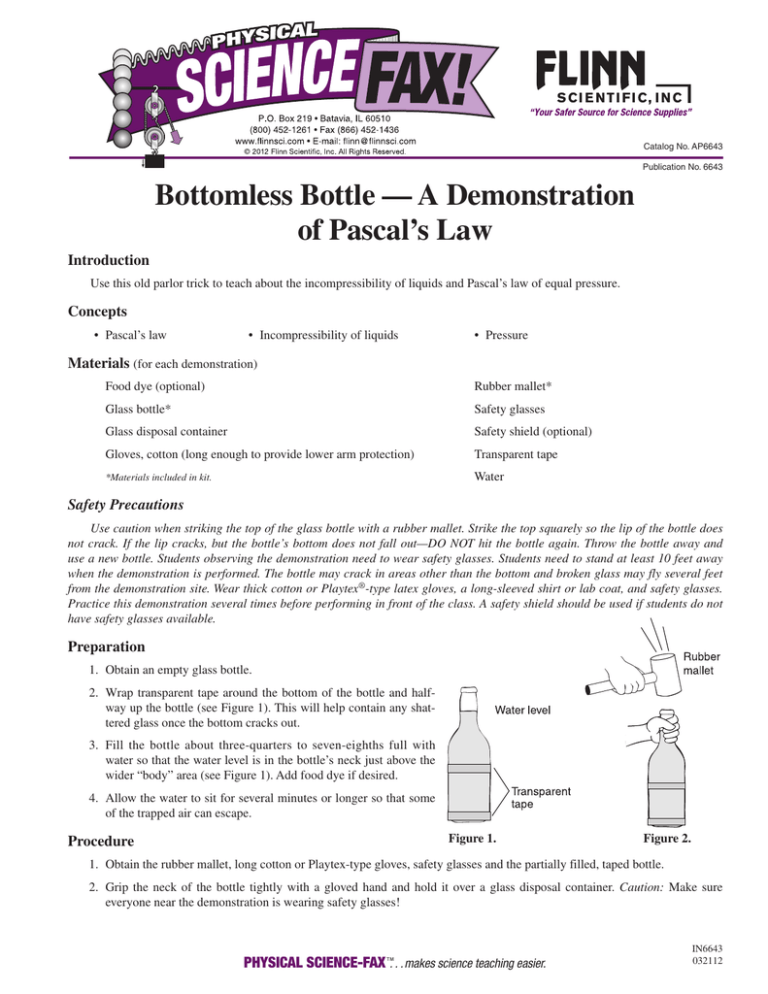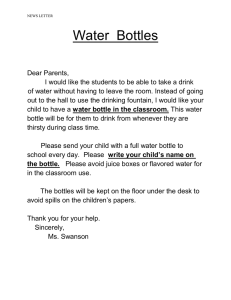
Catalog No. AP6643
Publication No. 6643
Bottomless Bottle — A Demonstration
of Pascal’s Law
Introduction
Use this old parlor trick to teach about the incompressibility of liquids and Pascal’s law of equal pressure.
Concepts
• Pascal’s law
• Incompressibility of liquids
• Pressure
Materials (for each demonstration)
Food dye (optional)
Rubber mallet*
Glass bottle*
Safety glasses
Glass disposal container
Safety shield (optional)
Gloves, cotton (long enough to provide lower arm protection)
Transparent tape
*Materials included in kit.Water
Safety Precautions
Use caution when striking the top of the glass bottle with a rubber mallet. Strike the top squarely so the lip of the bottle does
not crack. If the lip cracks, but the bottle’s bottom does not fall out—DO NOT hit the bottle again. Throw the bottle away and
use a new bottle. Students observing the demonstration need to wear safety glasses. Students need to stand at least 10 feet away
when the demonstration is performed. The bottle may crack in areas other than the bottom and broken glass may fly several feet
from the demonstration site. Wear thick cotton or Playtex®-type latex gloves, a long-sleeved shirt or lab coat, and safety glasses.
Practice this demonstration several times before performing in front of the class. A safety shield should be used if students do not
have safety glasses available.
Preparation
1. Obtain an empty glass bottle.
2. Wrap transparent tape around the bottom of the bottle and halfway up the bottle (see Figure 1). This will help contain any shattered glass once the bottom cracks out.
3. Fill the bottle about three-quarters to seven-eighths full with
water so that the water level is in the bottle’s neck just above the
wider “body” area (see Figure 1). Add food dye if desired.
4. Allow the water to sit for several minutes or longer so that some
of the trapped air can escape.
Procedure
Figure 1.
Figure 2.
1. Obtain the rubber mallet, long cotton or Playtex-type gloves, safety glasses and the partially filled, taped bottle.
2. Grip the neck of the bottle tightly with a gloved hand and hold it over a glass disposal container. Caution: Make sure
everyone near the demonstration is wearing safety glasses!
PHYSICAL SCIENCE-FAX. . .makes science teaching easier.
IN6643
032112
3. Firmly strike the top opening of the bottle with the rubber mallet. Make sure the end of the rubber mallet strikes the opening squarely (see Figure 2). (The bottom of the glass bottle should break and fall into the glass disposal container along
with the water.) Caution: If the bottom of the bottle does not “fall out” with the first blow, but the bottle’s body or the lip
cracks or chips—DO NOT strike the bottle again. Use a new bottle.
4. Show the broken bottle to the class. Caution: DO NOT pass the bottle around to the class or allow the students to hold it. There
will be many sharp edges that could easily injure the students.
5. Dispose of or recycle the broken bottle appropriately.
Disposal
Please consult your current Flinn Scientific Catalog/Reference Manual for general guidelines and specific procedures, and
review all federal, state and local regulations that may apply, before proceeding. It is recommended that this demonstration be
done directly over a glass disposal container. Paper towels may be placed in the bottom of the container to absorb the water. If
done over a garbage can, dispose of broken glass properly.
Tips
• This kit includes enough bottles to perform the demonstration 12 times. Use a few bottles for initial practice.
• It is important to practice this demonstration several times before performing in front of the class to get a feel for how hard
to strike the top of the bottle. It typically does not take a very hard hit to break the bottom out of the bottle.
Discussion
Blaise Pascal (1623–1662) is well known as a mathematician but he also performed many experiments involving pressure in
fluids. One of the principles he developed with fluids became known as Pascal’s principle or Pascal’s law. Pascal’s law states that
pressure applied anywhere to a fluid is transmitted undiminished in all directions. This law serves as a basis and exploration for
much of what is now known as hydraulics.
In the Bottomless Bottle demonstration, the force of the rubber mallet striking the top of the bottle causes the air inside the
bottle’s neck to compress slightly (because of inertia and the brief airtight seal around the bottle’s opening). The compressed air
travels through the bottle’s neck as a shock wave (through compression and rarefraction) until the compression wave reaches
the water level. At this point, the water will not compress. Instead, the force from the shock wave increases the pressure on the
liquid. This pressure is then distributed equally to all points of the bottle holding the water. Pressure is equal to a force per unit
area (P = F/A). Therefore, under constant pressure, a region of the container with a large surface area will experience a greater
total force compared to a region with a smaller surface area. The small force that is applied to the water in the narrow neck of the
bottle (from the compressed air) multiplies into a much larger force in the wider “body” portion. Depending on the bottle dimensions (neck diameter versus bottom diameter), this force may increase by 5 to 20 times at the bottom of the bottle. This large force
causes the bottom of the bottle to “pop” out.
An alternative explanation for the force that “pops” the bottom out has to do with cavitation. When the top of the bottle is
struck with the mallet, the bottle moves downward. The water inside the bottle, however, does not move down due to inertia. This
briefly creates a vacuum at the bottom of the bottle. As a result of the low pressure area, tiny bubbles of water vapor form. When
the water does move down, the bubbles collapse, creating a shock wave. This rapid formation and implosion of bubbles is known
as cavitation. The combined force of all the collapsing bubbles is enough to break away the bottom of the bottle.
Connecting to the National Standards
This laboratory activity relates to the following National Science Education Standards (1996):
Unifying Concepts and Processes: Grades K–12
Evidence, models, and explanation
Constancy, change, and measurement
Content Standards: Grades 5–8
Content Standard A: Science as Inquiry
Content Standard B: Physical Science, properties and changes of properties in matter, understanding of motions and
forces, transfer of energy
–2–
© 2012 Flinn Scientific, Inc. All Rights Reserved.
IN6643
Content Standards: Grades 9–12
Content Standard A: Science as Inquiry
Content Standard B: Physical Science, structure of atoms, structure and properties of matter, motions and forces, conservation of energy and increase in disorder, interactions of energy and matter
Acknowledgment
Special thanks to Todd Everson, Milwaukee School of Languages, Milwaukee, WI for providing the cavitation explanation
for this activity to Flinn Scientific.
The Bottomless Bottle—A Demonstration of Pascal’s Law is available from Flinn Scientific, Inc.
Catalog No.
AP6643
AP8829
SE1041
AP3234
Description
Bottomless Bottle
Glass Disposal Container
Gloves, for rough/sharp materials
Gloves, Platex®-type, Large
Consult your Flinn Scientific Catalog/Reference Manual for current prices.
–3–
© 2012 Flinn Scientific, Inc. All Rights Reserved.
IN6643



